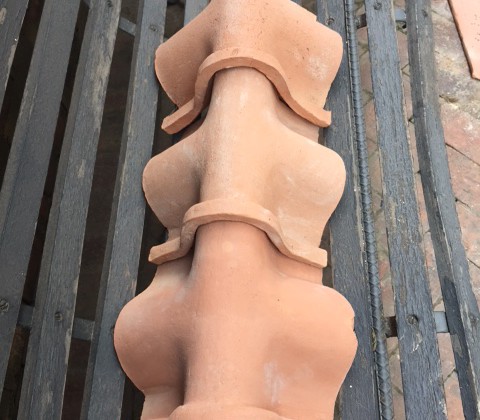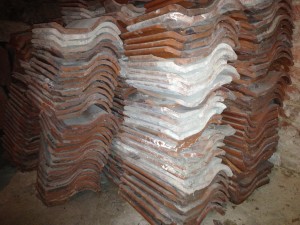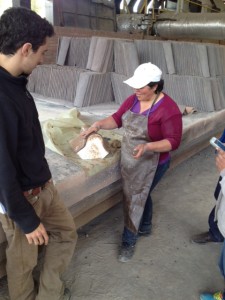Tiles for Library Roof Custom-Made in South America
By Wiley Wood
When the Norfolk Library’s new roof is laid in the coming months, its red terra cotta tiles will be modern replicas of the ones that were originally chosen in the 1880’s. Their material comes from clay beds in Colombia, and the custom-made S-shaped tiles will be produced at a family-owned factory just outside of Bogotà.
On a village green where white clapboard siding prevails, the Norfolk Library—with its red sandstone lower course, its upper walls coated in fishscale tiles, its roofed turrets and Romanesque arches—is an exotic presence, inserting into the town’s white-steepled New England spareness a note of swarthy Romanticism.
The decision to restore the original tile was made by the library’s directors following an inspection of the building’s exterior with preservation architect John G. Waite. The asphalt roofing, which dated from the 1940’s, was letting water infiltrate the walls and needed replacement. Tile, the board reasoned, is long-lasting, promotes airflow to reduce attic temperatures and provides a textured surface in keeping with the library’s sculptural walls.
“The whole building will look brighter, crisper,” says Samuel “Pete” Anderson, a Norfolk architect.
Fortunately, a stack of the original tiles was tucked away in a corner of the library’s basement. They are S-shaped, with a convex barrel and a concave pan. When laid in a row, the barrel of one tile overlaps the pan of the adjoining one, and in successive rows the barrels form a patterned ridge and the pans a water channel.
The tiles from 1889 are small (it will take more than 14,000 to cover the roof), have an unusual flat pan, and their rounded barrel is similar in arc to the fishscale tiles that shingle the library’s upper walls. Stuart Matthews, a tile importer, describes them as “a Spanish S-tile, very different from what is regularly available.”
Charged with replicating the original, Matthews first made a template, sizing it slightly larger than the eventual tile to account for the higher water content of the clay during shaping. He took the result down to the factory in Colombia. “There, I met the Colombian women who make the custom pieces,” said Matthews. “I don’t speak Spanish, they don’t speak English, but soon we were up to our armpits in clay, understanding each other perfectly.”
The factory’s prototypes are tested at an independent lab in Pittsburgh for adherence to ASTM standards, then checked by the architect for color and fit. The testing completed, the factory goes into production. “Making them, that’s the easy bit,” says Matthews, who maintains that his tiles will last a hundred years or more, even in the rugged climate of New England.
In addition to the field tiles that cover the flat portions of the roof, Matthews will oversee the fabrication of 350 highly unusual ridge tiles. Sculpted to encase the ridge-and-valley shape of the field tiles, “they fit together like Legos,” says architect Kate Johnson. “It means less mortar in the gaps and a more elegant design.”
The Norfolk Library will spend about $490,000 on the restoration of the roof, which includes rebuilding the stone chimneys, removing the existing asphalt shingles, laying the tile and installing appropriate gutters. Of that, $200,000 comes from a State of Connecticut grant.
Although the tiles are only in the process of being color-checked as of this writing, Ann Havemeyer, director of the Norfolk Library, is confident that the new roof will be in place by the time the snow flies in October.



